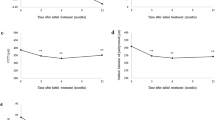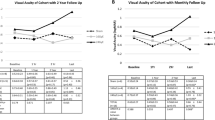Abstract
Purpose
To assess the efficacy of intravitreal aflibercept in patients suffering from post-radiation macular edema following plaque radiotherapy for choroidal melanoma.
Methods
This prospective, interventional case series included patients affected by radiation maculopathy (RM) with macular edema secondary to ruthenium-106 plaque brachytherapy for choroidal melanoma. The effect of intravitreal aflibercept on best-corrected visual acuity (BCVA), central foveal thickness (CFT) detected by spectral domain optical coherence tomography (sd-OCT), and Horgan’s grading scale of RM was evaluated throughout the 24-month follow-up. Intraocular pressure (IOP) and possible complications were also recorded.
Results
Nine eyes of 9 patients were included. A mean of 4.4 ± 1.2 injections were given over the 24 months. At the end of follow-up, mean BCVA was significantly improved, from 0.9 ± 0.19 logMAR at baseline to 0.56 ± 0.3 logMAR (P = 0.028), and mean CFT was significantly decreased, from 546 ± 123 μm at baseline to 223 ± 34 μm (P < 0.001). Intravitreal aflibercept lowered baseline maculopathy stage as well. No significant change in IOP values and no complications, such as endophthalmitis, was recorded.
Conclusion
Intravitreal aflibercept is an effective treatment for patients with radiation-induced macular edema, allowing functional and anatomical improvements to be achieved with a relatively low number of injections.


Similar content being viewed by others
References
Gündüz K, Shields CL, Shields JA, Cater J, Freire JE, Brady LW (1999) Radiation complications and tumor control after plaque radiotherapy of choroidal melanoma with macular involvement. Am J Ophthalmol 127:579–589
Emami B, Lyman J, Brown A et al (1991) Tolerance of normal tissue to therapeutic irradiation. Int J Radiat Oncol Biol Phys 21:109–122
Shields CL, Demirci H, Marr BP, Mashayekhi A, Dai VV, Materin MA, Shields JA (2006) Intravitreal triamcinolone acetonide for acute radiation papillopathy. Retina 26(5):537–544
Archer DB, Amoaku WM, Gardiner TA (1991) Radiation retinopathy – clinical, histopathological, ultrastructural and experimental correlations. Eye (Lond) 5(Pt 2:239–251
Gragoudas ES, Li W, Lane AM, Munzenrider J, Egan KM (1999) Risk factors for radiation maculopathy and papillopathy after intraocular irradiation. Ophthalmology 106:1571–1577
Finger PT, Kirli M (2005) Laser photocoagulation for radiation retinopathy after ophthalmic plaque radiation therapy. Br J Ophthalmol 89:730–738
Bakri SJ, Beer PM (2005) Photodynamic therapy for maculopathy due to radiation retinopathy. Eye (Lond) 19:795–799
Russo A, Reibaldi M, Avitabile T et al (2018) Dexamethasone intravitreal implant vs ranibizumab in the treatment of macular edema secondary to brachytherapy for choroidal melanoma. Retina 38(4):788–794
Finger PT (2008) Radiation retinopathy is treatable with anti-vascular endothelial growth factor bevacizumab (Avastin). Int J Radiat Oncol Biol Phys 70:974–977
Finger PT, Chin KJ (2010) Intravitreous ranibizumab (Lucentis) for radiation maculopathy. Arch Ophthalmol 128:249–252
Kim IK, Lane AM, Jain P, Awh C, Gragoudas ES (2016) Ranibizumab for the prevention of radiation complications in patients treated with proton beam irradiation for choroidal melanoma. Trans Am Ophthalmol Soc 114:T2
Ikuno Y, Ohno-Matsui K, Wong TY, Korobelnik JF, Vitti R, Li T, Stemper B, Asmus F, Zeitz O, Ishibashi T, MYRROR Investigators (2015) Intravitreal aflibercept injection in patients with myopic choroidal neovascularization: The MYRROR Study. Ophthalmology 122(6):1220–1227
Stewart MW, Rosenfeld PJ (2008) Predicted biological activity of intravitreal VEGF trap. Br J Ophthalmol 92(5):667–668
Heier JS, Boyer D, Nguyen QD, Marcus D, Roth DB, Yancopoulos G, Stahl N, Ingerman A, Vitti R, Berliner AJ, Yang K, Brown DM, CLEAR-IT 2 Investigators (2011) The 1-year results of CLEAR-IT 2, a phase 2 study of vascular endothelial growth factor trap-eye dosed as-needed after 12-week fixed dosing. Ophthalmology 118:1098–1106
Brown DM, Heier JS, Ciulla T, Benz M, Abraham P, Yancopoulos G, Stahl N, Ingerman A, Vitti R, Berliner AJ, Yang K, Nguyen QD, CLEAR-IT 2 Investigators (2011) Primary endpoint results of a phase II study of vascular endothelial growth factor trap-eye in wet age related macular degeneration. Ophthalmology 118:1089–1097
Khan MA, Mashayekhi A, Shields JA, Shields CL (2017) Intravitreal aflibercept as rescue therapy for post-radiation cystoid macular edema resistant to intravitreal bevacizumab: outcomes at 1 year. Ocul Oncol Pathol 3(4):313–319
Horgan N, Shields CL, Mashayekhi A, Shields JA (2010) Classification and treatment of radiation maculopathy. Curr Opin Ophthalmol 21:233–238
Oellers P, Mowery YM, Perez BA et al (2018) Efficacy and safety of low-dose iodine plaque brachytherapy for juxtapapillary choroidal melanoma. Am J Ophthalmol 186:32–40
Baillif S, Maschi C, Gastaud P, Caujolle JP (2013) Intravitreal dexamethasone 0.7-mg implant for radiation macular edema after proton beam therapy for choroidal melanoma. Retina 33:1784–1790
Seo KH, Yu SY, Kim M, Kwak HW (2016) Visual and morphologic outcomes of intravitreal ranibizumab for diabetic macular edema based on optical coherence tomography patterns. Retina 36(3):588–595
Reibaldi M, Parravano M, Varano M et al (2012) Foveal microstructure and functional parameters in lamellar macular hole. Am J Ophthalmol 154(6):974–980
Thompson JT, Glaser BM, Sjaarda RN, Murphy RP (1995) Progression of nuclear sclerosis and long-term visual results of vitrectomy with transforming growth factor beta-2 for macular holes. Am J Ophthalmol 119:48–54
Tah V, Orlans HO, Hyer J, Casswell E, Din N, Sri Shanmuganathan V, Ramskold L, Pasu S (2015) Anti-VEGF therapy and the retina: an update. J Ophthalmol 2015:627674
Finger PT, Chin KJ (2013) High-dose (2.0 mg) intravitreal ranibizumab for recalcitrant radiation retinopathy. Eur J Ophthalmol 23(6):850–856
Finger PT, Chin KJ, Semenova EA (2016) Intravitreal anti-VEGF therapy for macular radiation retinopathy: a 10-year study. Eur J Ophthalmol 26(1):60–66
Finger PT, Chin K (2007) Anti-vascular endothelial growth factor bevacizumab (avastin) for radiation retinopathy. Arch Ophthalmol 125(6):751–756
Gupta A, Muecke JS (2008) Treatment of radiation maculopathy with intravitreal injection of bevacizumab (Avastin). Retina 28(7):964–968
Mason JO 3rd, Albert MA Jr, Persaud TO, Vail RS (2007) Intravitreal bevacizumab treatment for radiation macular edema after plaque radiotherapy for choroidal melanoma. Retina 27(7):903–907
Khan MA, Mashayekhi A, Ferguson K, Shields JA, Shields CL (2017) High-dose (2.5 mg) intravitreal bevacizumab as rescue therapy for persistent postradiationcystoid macular edema. Ocul Oncol Pathol 3(3):168–175
Mashayekhi A, Rojanaporn D, Al-Dahmash S, Shields CL, Shields JA (2014) Monthly intravitreal bevacizumab for macular edema after iodine-125 plaque radiotherapy of uveal melanoma. Eur J Ophthalmol 24(2):228–234
Stacey AW, Demirci H (2016) Serial intravitreal bevacizumab injections slow the progression of radiation maculopathy following Iodine-125 plaque radiotherapy. Open Ophthalmol J 10:103–110
Pooprasert P, Young-Zvandasara T, Al-Bermani A (2017) Radiation retinopathy treated successfully with aflibercept. BMJ Case Rep 9:2017
Loukianou E, Loukianou G (2017) Intravitreal aflibercept in recalcitrant radiation maculopathy due to external beam radiotherapy for nasopharyngeal cancer: a first case report. Case Rep Ophthalmol 8(1):87–90
Sakamoto A, Nishijima K, Kita M, Oh H, Tsujikawa A, Yoshimura N (2009) Association between foveal photoreceptor status and visual acuity after resolution of diabetic macular edema by pars plana vitrectomy. Graefes Arch Clin Exp Ophthalmol 247(10):1325–1330
Shah NV, Houston SK, Markoe AM, Feuer W, Murray TG (2012) Early SD-OCT diagnosis followed by prompt treatment of radiation maculopathy using intravitreal bevacizumab maintains functional visual acuity. Clin Ophthalmol 6:1739–1748
Diabetic Retinopathy Clinical Research Network, Wells JA, Glassman AR, Ayala AR et al (2015) Aflibercept, bevacizumab, or ranibizumab for diabetic macular edema. N Engl J Med 372(13):1193–1203
Park DH, Sun HJ, Lee SJ (2016) A comparison of responses to intravitreal bevacizumab, ranibizumab, or aflibercept injections for neovascular age-related macular degeneration. Int Ophthalmol. https://doi.org/10.1007/s10792-016-0391-4
Shaikh AH, Toussaint BW, Miller DM, Petersen MR, Foster RE, Riemann CD, Hutchins RK, Sisk RA (2015) Cost comparison of intravitreal aflibercept with bevacizumab and ranibizumab for the treatment of wet age-related macular degeneration. Ophthalmic Surg Lasers Imaging Retina 46(1):62–66
Caminal JM, Flores-Moreno I, Arias L et al (2015) Intravitreal dexamethasone implant for radiation maculopathy secondary to plaque brachytherapy in choroidal melanoma. Retina 35:1890–1897
Tarmann L, Langmann G, Mayer C et al (2014) Ozurdex reduces the retinal thickness in radiation maculopathy refractory to bevacizumab. Acta Ophthalmol 92:e694–e696
Russo A, Avitabile T, Uva M et al (2012) Radiation macular edema after Ru-106 plaque brachytherapy for choroidal melanoma resolved by an intravitreal dexamethasone 0.7-mg implant. Case Rep Ophthalmol 3(1):71–76
Boyer DS, Yoon YH, Belfort R Jr et al (2014) Ozurdex MEAD study group three-year, randomized, sham-controlled trial of dexamethasone intravitreal implant in patients with diabetic macular edema. Ophthalmology 121(10):1904–1914
Groenewald C, Konstantinidis L, Damato B (2013) Effects of radiotherapy on uveal melanomas and adjacent tissues. Eye (Lond) 27(2):163–171
Acknowledgments
We wish to thank Dott. A. Bridgewood of the Scientific Bureau of the University of Catania for language support.
Author information
Authors and Affiliations
Corresponding author
Ethics declarations
Conflict of interest
Matteo Fallico declares that he has no conflict of interest. Michele Reibaldi declares that he has no conflict of interest. Teresio Avitabile declares that he has no conflict of interest. Antonio Longo declares that he has no conflict of interest. Vincenza Bonfiglio declares that she has no conflict of interest. Argyrios Chronopoulos declares that he has no conflict of interest. Rosario Caltabiano declares that he has no conflict of interest. Corrado Spatola declares that he has no conflict of interest. Andrea Russo declares that he has no conflict of interest.
Ethical approval
All procedures performed in studies involving human participants were in accordance with the ethical standards of the institutional and/or national research committee and with the 1964 Helsinki declaration and its later amendments or comparable ethical standards.
Informed consent
Informed consent was obtained from all individual participants included in the study.
Additional information
Publisher’s note
Springer Nature remains neutral with regard to jurisdictional claims in published maps and institutional affiliations.
Rights and permissions
About this article
Cite this article
Fallico, M., Reibaldi, M., Avitabile, T. et al. Intravitreal aflibercept for the treatment of radiation-induced macular edema after ruthenium 106 plaque radiotherapy for choroidal melanoma. Graefes Arch Clin Exp Ophthalmol 257, 1547–1554 (2019). https://doi.org/10.1007/s00417-019-04347-6
Received:
Revised:
Accepted:
Published:
Issue Date:
DOI: https://doi.org/10.1007/s00417-019-04347-6




